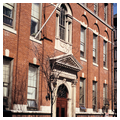Edmund Wheelwright served as Boston city architect from 1891 to 1895, designing fire stations, police stations, park buildings, and schoolhouses of distinction. The Bowdoin School represents the issues he espoused in his 1901 book, School Architecture, such as using the Federal Revival here to relate to the surrounding environment and to reinforce the importance of native Boston traditions for the immigrant children attending this school. The brick with limestone–trimmed school commanded a steeply sloping site, allowing two classrooms at the basement rear of the building, a library on the second floor, and an assembly room at the top level, which complemented the generously scaled classrooms. Like many redundant institutional buildings, the grammar school became the Bowdoin School Apartments in 1977.
You are here
Bowdoin School
If SAH Archipedia has been useful to you, please consider supporting it.
SAH Archipedia tells the story of the United States through its buildings, landscapes, and cities. This freely available resource empowers the public with authoritative knowledge that deepens their understanding and appreciation of the built environment. But the Society of Architectural Historians, which created SAH Archipedia with University of Virginia Press, needs your support to maintain the high-caliber research, writing, photography, cartography, editing, design, and programming that make SAH Archipedia a trusted online resource available to all who value the history of place, heritage tourism, and learning.
























